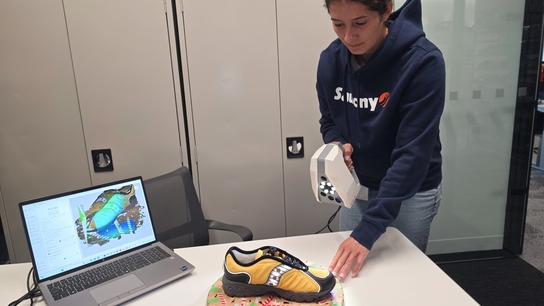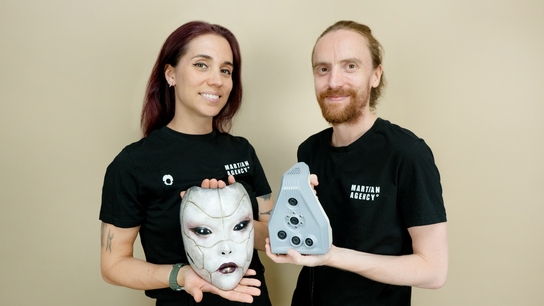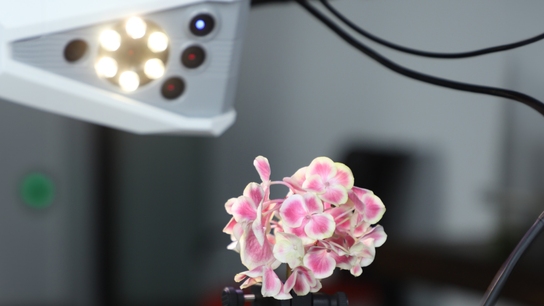Artec Eva becomes an outside-the-box solution for accurate breast volume measurement
Challenge: Scientists at the University of Portsmouth needed a non-invasive, quick, and easy tool to measure breast volume precisely for research in breast health and bra science.
Solution: Artec Eva, Artec Studio
Result: Breast volume was measured accurately, with a maximum difference between actual and measured breast volume of 0.8%. Together with a processing error of 0.1%, the total error was a maximum of 0.9%.
Why Artec 3D: Artec 3D solutions have been irreplaceable in healthcare applications across the globe, providing medical professionals and researchers with reliable tools for fast, safe, non-invasive scanning.

Scanning with Artec Eva to obtain precise breast volume measurements
Fun fact: breasts are uniquely human. Of all 5,000 existing mammals, it is only Homo sapiens that have permanent breasts, also with an established significance in social and cultural discourse. Both a potent symbol of nature and vitality and a multi-dimensional concept associated with embodiment, gender, sensuality, and empowerment, the breast remains a treasured yet highly vulnerable attribute, often getting only a limited kind of attention.
The perceptions and attitudes towards breast health are so profoundly complex that it can be a challenge in many cultures to plan public health initiatives or raise awareness of breast care. With this in mind, the Research Group in Breast Health at the University of Portsmouth set a high goal of improving women’s quality of life by improving scientific knowledge of breast health and helping develop breast-related products.
Understanding how breast support is crucial to women’s well-being
The team of scientists under Professor Joanna Wakefield-Scurr has gained a reputation for international academic publications on breast biomechanics, bra science, and breast health, which helped them collaborate with some of the world’s major lingerie and sports apparel manufacturers. One of their signature projects is an innovative breast volume measurement, crucial to breast support in different environments and occupations, breast anthropometry, and breast pain alleviation.
Breast sizing matters when detecting breast changes, monitoring pressure on the spine and musculoskeletal system, and avoiding potential injuries, pain, or discomfort.
“The accurate objective measurement of breast volume is required for surgical interventions, but it is equally important in research into breast health and bra science,” Dr. Jacqueline Rix, Senior Research Associate, explained. Some reasons why breast sizing matters include detecting breast changes, estimating forces on the spine and musculoskeletal system, and avoiding potential injuries, pain, or discomfort across a range of activities.
According to the research, more than 80% of women have reportedly worn wrong-sized bras, which deprives them of appropriate breast support – this further stresses the need for educating women on bra fitting. The research group also managed to identify that the traditional breast sizing methods failed to provide the best fit, and then advocated a series of “Best Fit” criteria. To do this, the scientists had to come up with a method more advanced than tape measuring.
3D scanning for accurate breast volume measurements
For many of the studies conducted in the research group, the accurate and reliable measurement of breast volume is a must. When looking for the right way to do it, Dr. Chris Mills, Senior Lecturer in Biomechanics decided to try out Artec Eva, a structured-light 3D scanner with a reputation for speed and versatility. Back in 2017, Artec’s gold-certified partner Patrick Thorn & Co held an Eva demo at the university, which became a starting point for the collaboration.

In the years that followed, the research group worked with Eva and different versions of Artec Studio, also becoming one of the very first professionals to try out the then-beta version of Artec Studio 17. Dr. Rix recalled, “I’m awful at technology, so I was very worried (about learning how to use it) when I started the project. But it is really easy, really intuitive – it’s really difficult to go wrong.”
Artec Eva is famously used in health-related institutions across the globe for human body scanning because it is safe, quick, and accurate yet easy to use, so the specialists don’t need to spend additional time on becoming incredibly tech-savvy – something that may once have deterred the use of high technology in the field. Compact and lightweight, the scanner brings noticeable freedom to the scanning procedure when capturing human anatomy.
“Eva is handheld and movable,” Dr. Mills said. “Breasts are different shapes and sizes. When you scan, you’re moving around all the time to try and make sure you get all the shape in. Now that we know how accurate it is, we definitely wouldn’t change from Artec Eva.”
In the beginning of their experiment, the scientists needed to know if the accuracy of up to 0.01 mm that Eva promised would be enough and if the scanner’s processing techniques would influence their calculations. To check this, the team assessed the scanner’s accuracy by obtaining a total error in the measurement.
Processing that makes all the difference
The researchers scanned Play-Doh (a modeling compound by Hasbro, Rhode Island, USA) of a known volume with Artec Eva. They went on to process the obtained data in the Artec Studio’s Autopilot mode, removing the base and filling the Play-Doh breast in the Fix holes tab. Upon obtaining the volume in the Measures tab, they compared it to the actual volume of the Play-Doh used. The difference in the actual and measured volume was a maximum of 0.8% (3.8 ml), with a minimum of 0.2% (1.3 ml) between 535 ml and 715 ml.

First stage of the project: scanning Play-Doh of a known volume to assess the scanner’s accuracy
“First we wanted to know: if we scanned something of a known volume, would we get the same volume by using the 3D scanner? So we started with Play-Doh. We started with 235 milliliters and scanned it, and we went all the way up to over a thousand milliliters. It’s over a liter of Playdough, and we did every 15 milliliters, and the accuracy was amazing.”
However, human breasts are not uniform shapes on a flat surface, so the team sought volunteers for the project to be able to scan people with Eva and assess breast volume prediction. Before scanning, the scientists marked the breast boundary on the volunteer, got the breast scans with Eva, and processed them segmenting the breast from the torso. The process was repeated five times.
“Every time we calculated it, we were within one milliliter every time of volume, which is incredible.”
“We used eyeliner pencil to draw around the breast, creating a very thin line, and we managed to segment the breast from the torso within the line of the eyeliner pencil. To make sure we were getting the same results, we used the scan from the same participant: we erased and re-segmented the breast from the torso, so we processed and calculated breast volume five times. And every time we calculated volume, we were within one milliliter, which is incredible,” Dr. Rix described.
With a little help from Artec 3D
One thing the researchers highlighted was excellent support from Patrick Thorn and his team. “We were able to work closely with the Artec team to highlight the current limitations of the Studio version we were using, and they significantly enhanced the processing features in Artec Studio 17,” Thorn said. “These enhancements reduced the breast volume prediction error from 4.2% down to 0.1%.”

Processing the breast scans in Artec Studio
These gratifying results inspired many more measuring sessions since the breast volume could now be obtained quickly and non-invasively, with no pain or stress for the participants. The ability to take accurate and reliable measurements means a lot to the team, whose projects help deeply affect and improve bra comfort, breast support, and reduction in breast pain for many women.
“We’re trying to encourage companies to think how to make bras more practical, more wearable, more comfortable – a product that actually helps women.”
Due to their amazing reputation both nationally and internationally, the research group gets to work with the university communities and fellow scientists, sign specific professional contracts, and even campaign with a number of sports teams to say that the bra is a specialist equipment sportswomen should be able to choose.
“We’re definitely trying to change the perception of the bra and make sure women can choose what’s most comfortable and that they get the support that they need for either their occupation or their sport. And I think we’re trying to encourage companies to think how to make it more practical, more wearable, more comfortable. A product that actually helps women, not just looks pretty. I think the possibilities for the technology are really massive in our field,” concluded Dr. Rix.
With this focus on offering appropriate solutions to women, the research group is definitely at the forefront of cutting-edge methodology in the area – proving yet again that the ultimate goal of science, technology, and innovation boils down to simply making people’s lives better.
Scanners behind the story
Try out the world's leading handheld 3D scanners.





